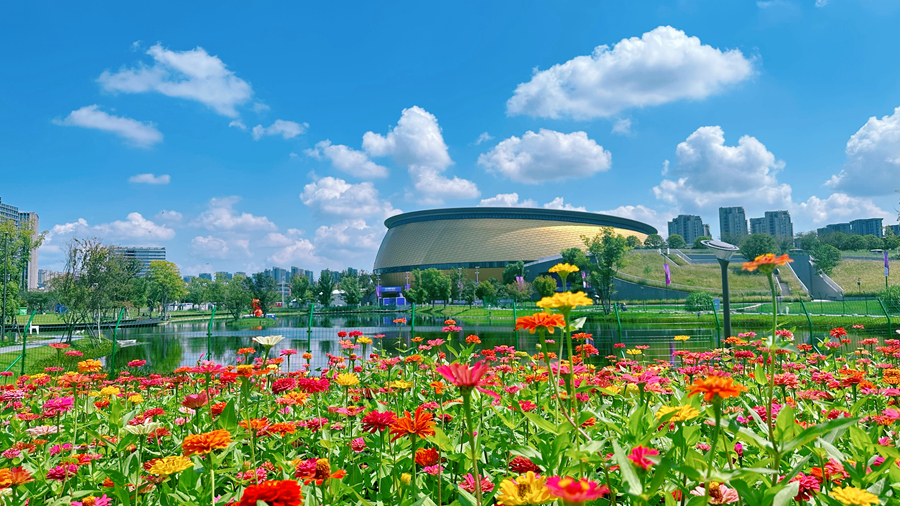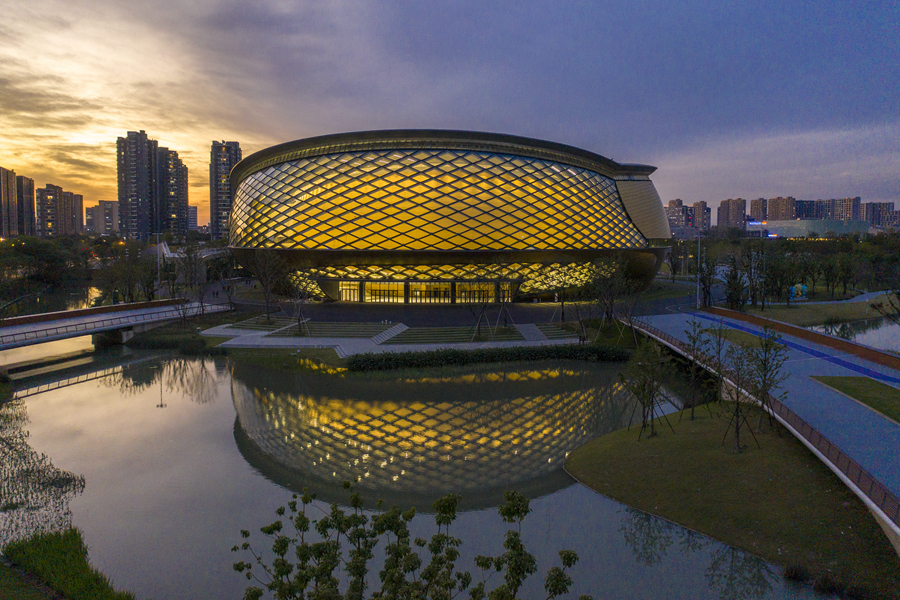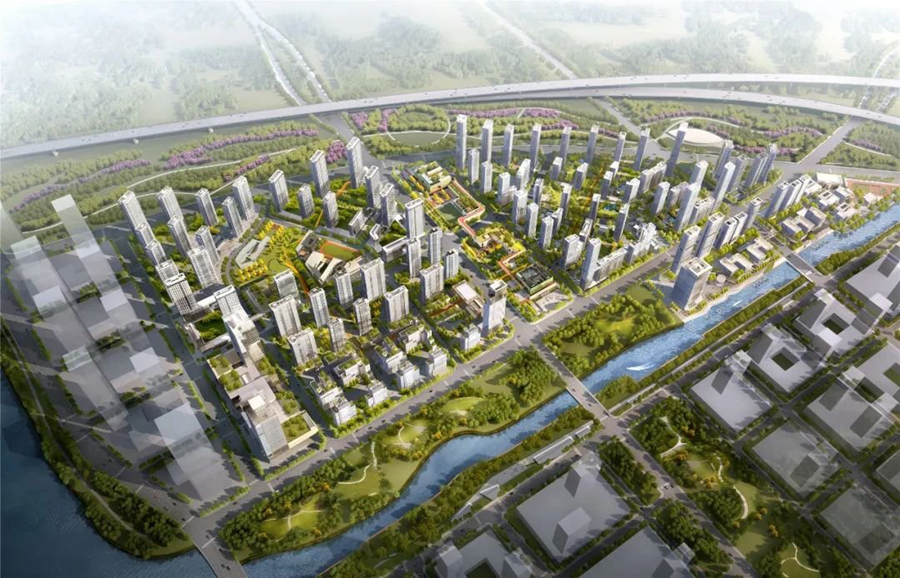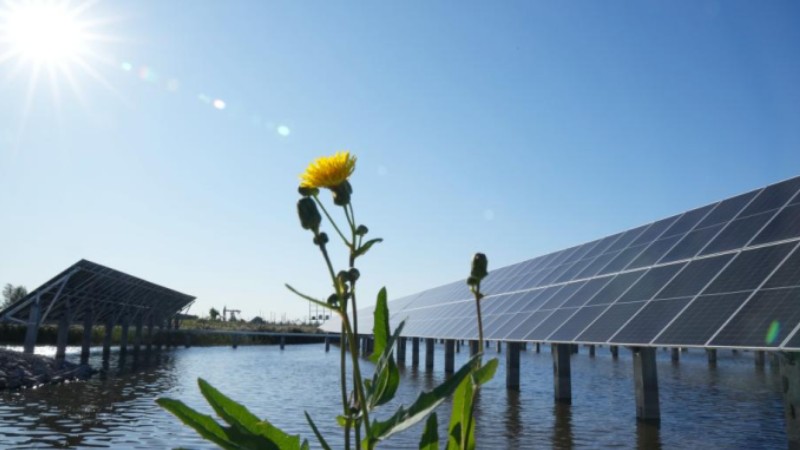Hangzhou set to host first carbon-neutral Asian Games

A view of the Gongshu Canal Sports Park Gymnasium in Hangzhou, east China’s Zhejiang Province. (Photo courtesy of the Organizing Committee of the Hangzhou Asian Games)
Located in Gongshu Canal Sports Park in Hangzhou, the capital of China's Zhejiang Province, a gymnasium resembling a jade cong, a ritual vessel from ancient China, has captured the attention of many. Covering an area of 21,477 square meters, this irregularly oval-shaped gymnasium will host table tennis and breakdance competitions during the Hangzhou Asian Games.
Surrounded by a crystal-clear river and lush trees, this venue is the first sports facility in Zhejiang Province to receive a three-star green building design certification, symbolizing the green ethos of the Hangzhou Asian Games.
As China unveils its roadmap to peak carbon emissions by 2030 and achieve carbon neutrality by 2060, Hangzhou has committed to green and low-carbon development, striving to establish a resource-saving and eco-friendly Asian Games.
Sustainability takes center stage at Hangzhou Asian Games
Green, low-carbon and sustainable development have emerged as the prevailing themes and evolving trends of the Olympic Games. In this context, the Hangzhou Asian Games promise to adhere to the principles of being "green, smart, economical, and ethical," with "green" taking precedence among these four organizing principles.

A view of the Gongshu Canal Sports Park Gymnasium in Hangzhou, east China’s Zhejiang Province. (Photo courtesy of the Organizing Committee of the Hangzhou Asian Games)
The Organizing Committee of the Hangzhou Asian Games (HAGOC) has translated these principles into action. Wang Minghua, the deputy director of ceremonies and events at HAGOC, emphasized in an exclusive interview with People's Daily Online that “HAGOC integrates green, low-carbon and sustainable principles into every aspect of its preparation and operations – before, during and after the games.”
In laying the foundation for a spectacular event, HAGOC has placed significant emphasis on the green design and construction of venues. The aforementioned gymnasium serves as a notable example. “This project uses ‘sponge city’ technology, such as artificial wetlands, to recycle rainwater for plant irrigation, cutting water consumption by up to 40 percent. Skylight tubes installed on the roof of this stadium channel natural light into the venue, ensuring ample daylight and reducing electricity consumption,” Wang noted.
Staging the first-ever carbon-neutral Asian Games
To achieve the ambitious goal of hosting the first-ever carbon-neutral Asian Games, substantial efforts have been directed towards reducing carbon emissions in all sectors, encompassing venue construction, venue operation, spectator activities, and large-scale events.
“Among the 56 competition venues designated for the Asian Games and Asian Para Games, only 12 are newly built and 26 are revamped versions of existing structures. Nine venues are extensions and the remaining nine are temporary facilities,” said Wang.

Photo shows wind turbines in northwest China. (Photo courtesy of the Organizing Committee of the Hangzhou Asian Games)
The utilization of renewable energy also reflects HAGOC's unwavering commitment to a "zero-carbon event." The Asian Games Village and venues will be powered by green electricity sourced from western China, including photovoltaic power from the Ningxia Hui Autonomous Region and wind power from the Xinjiang Uygur Autonomous Region.
“Unavoidable carbon emissions will be offset through carbon quotas, carbon credits and carbon sink forest donations provided by various entities, and ultimately achieving carbon neutrality,” Wang added.
Asian Games: Paving the path to a better city
“HAGOC not only aims to achieve carbon neutrality for the event; it also emphasizes the importance of widespread societal involvement,” said Wang. Organizers hope that the Hangzhou Asian Games will mark the beginning of a green and low-carbon mindset that will eventually become ingrained in social norms.
The committee has launched a variety of initiatives to foster stronger public engagement. The "1kg from everyone to help make the Asian Games carbon neutral" campaign encourages citizens to support carbon neutrality at the Asian Games by adopting green lifestyles. To date, over 106 million people have participated. The "Plant Trees for the Asian Games" campaign has created 26 carbon-neutral forests.

A full view of the green landscaping in the 19th Asian Games Village in Hangzhou, east China's Zhejiang Province. (Photo courtesy of the Organizing Committee of the Hangzhou Asian Games)
According to Wang, the distinctive approach to carbon neutrality taken by the Hangzhou Asian Games “provides a model for green operations at large-scale events” and “offers various case studies for urban green and low-carbon development in the future.”
By employing green practices, the Hangzhou Asian Games showcase China's vivid commitment to environmental protection and sustainable development. The eco-friendly Asian Games signal the dawn of a greener life and future.
(Guo Siqi, as an intern, also contributed to this article.)
Photos
Related Stories
- 19th Asian Games: table tennis women's team preliminary matches
- Highlights of women's beach volleyball preliminary match at 19th Asian Games
- Interview: Hangzhou Asian Games reflect Asian fraternity, prosperity, says Nepali PM
- Qin Haiyang, Yang Liwei announced flag bearers for Chinese Asian Games delegation
- China's Dual Carbon commitment: Paving the way for the greenest Asian Games yet
- Preview: China's 3x3 basketball teams may undergo "extreme adjustments"
- Fencing preview: China aims to bounce back from recent lows in Hangzhou
- Tennis preview: China eye new heights at Hangzhou Asian Games
- China, S.Korea reach last 16 in Asiad men's football event
- Highlights of volleyball match at 19th Asian Games
Copyright © 2023 People's Daily Online. All Rights Reserved.









